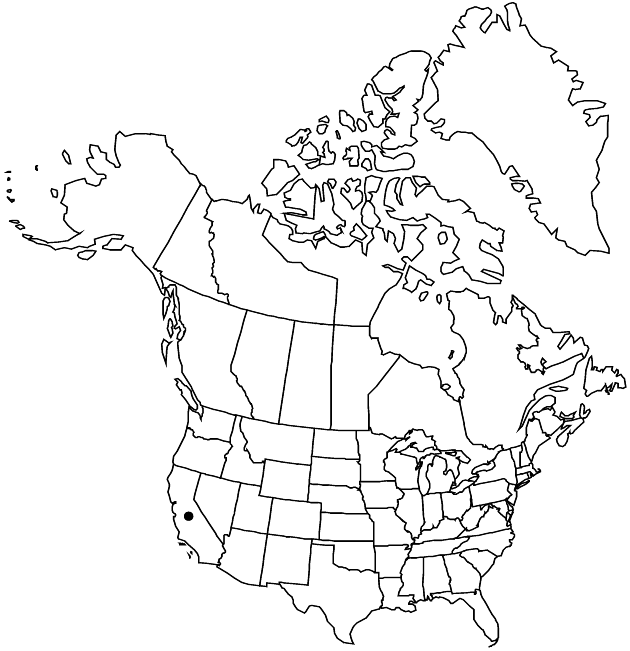Difference between revisions of "Deinandra halliana"
Novon 9: 468. 1999.
FNA>Volume Importer |
imported>Volume Importer |
||
| (6 intermediate revisions by 2 users not shown) | |||
| Line 7: | Line 7: | ||
|year=1999 | |year=1999 | ||
}} | }} | ||
| − | |basionyms={{Treatment/ID/ | + | |special_status={{Treatment/ID/Special_status |
| + | |code=E | ||
| + | |label=Endemic | ||
| + | }}{{Treatment/ID/Special_status | ||
| + | |code=C | ||
| + | |label=Conservation concern | ||
| + | }} | ||
| + | |basionyms={{Treatment/ID/Basionym | ||
|name=Hemizonia halliana | |name=Hemizonia halliana | ||
|authority=D. D. Keck | |authority=D. D. Keck | ||
| + | |rank=species | ||
| + | |publication_title=Madroño | ||
| + | |publication_place=3: 12. 1935 | ||
}} | }} | ||
|synonyms= | |synonyms= | ||
| Line 27: | Line 37: | ||
|distribution=Calif. | |distribution=Calif. | ||
|discussion=<p>Of conservation concern.</p><!-- | |discussion=<p>Of conservation concern.</p><!-- | ||
| − | --><p>Deinandra halliana occurs in the Inner South Coast Ranges. Evident population sizes vary greatly from year to year; active plants may be absent in dry years and form dense stands in some wet years. Madia radiata is morphologically similar to D. halliana; the two species sometimes co-occur and can be difficult to distinguish without close examination of phyllaries and cypselae.</p> | + | --><p><i>Deinandra halliana</i> occurs in the Inner South Coast Ranges. Evident population sizes vary greatly from year to year; active plants may be absent in dry years and form dense stands in some wet years. <i>Madia radiata</i> is morphologically similar to <i>D. halliana</i>; the two species sometimes co-occur and can be difficult to distinguish without close examination of phyllaries and cypselae.</p> |
|tables= | |tables= | ||
|references= | |references= | ||
| Line 36: | Line 46: | ||
-->{{#Taxon: | -->{{#Taxon: | ||
name=Deinandra halliana | name=Deinandra halliana | ||
| − | |||
|authority=(D. D. Keck) B. G. Baldwin | |authority=(D. D. Keck) B. G. Baldwin | ||
|rank=species | |rank=species | ||
| Line 50: | Line 59: | ||
|publication title=Novon | |publication title=Novon | ||
|publication year=1999 | |publication year=1999 | ||
| − | |special status= | + | |special status=Endemic;Conservation concern |
| − | |source xml=https:// | + | |source xml=https://bitbucket.org/aafc-mbb/fna-data-curation/src/2e0870ddd59836b60bcf96646a41e87ea5a5943a/coarse_grained_fna_xml/V19-20-21/V21_696.xml |
|tribe=Asteraceae tribe Heliantheae | |tribe=Asteraceae tribe Heliantheae | ||
|subtribe=Asteraceae (tribe Heliantheae) subtribe Madiinae | |subtribe=Asteraceae (tribe Heliantheae) subtribe Madiinae | ||
Latest revision as of 21:13, 5 November 2020
Annuals, 15–120 cm. Stems fistulose. Leaves: proximal blades entire or serrate, faces glabrous (margins and midribs sometimes scabrous or hispid). Heads in open, corymbiform, racemiform, or paniculiform arrays. Bracts subtending heads usually not overlapping involucres. Phyllaries evenly stipitate-glandular, including margins and apices, usually with some non-glandular, non-pustule-based hairs as well. Paleae in 1 series. Ray florets (8–)10–14; laminae deep yellow, 5–10 mm. Disc florets 28–60, all functionally staminate; anthers yellow or brownish. Pappi 0 (reportedly sometimes rudimentary). 2n = 20.
Phenology: Flowering Apr–May.
Habitat: Grasslands, edges of alkali sinks, open muddy slopes, heavy, ± alkaline, clayey soils
Elevation: 300–1000 m
Discussion
Of conservation concern.
Deinandra halliana occurs in the Inner South Coast Ranges. Evident population sizes vary greatly from year to year; active plants may be absent in dry years and form dense stands in some wet years. Madia radiata is morphologically similar to D. halliana; the two species sometimes co-occur and can be difficult to distinguish without close examination of phyllaries and cypselae.
Selected References
None.
